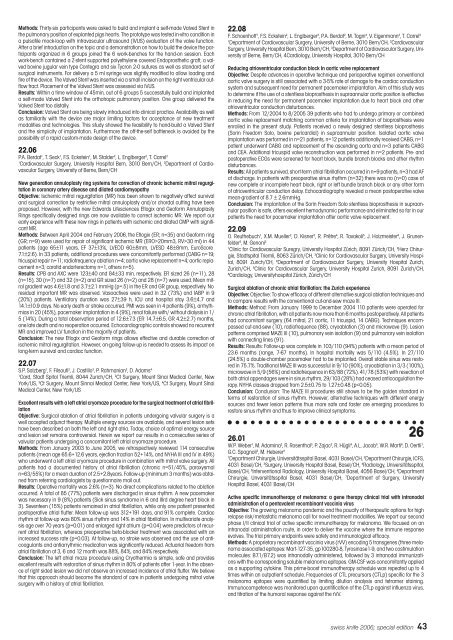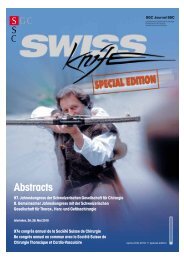Abstracts 4. Gemeinsamer Jahreskongress der ... - SWISS KNIFE
Abstracts 4. Gemeinsamer Jahreskongress der ... - SWISS KNIFE
Abstracts 4. Gemeinsamer Jahreskongress der ... - SWISS KNIFE
You also want an ePaper? Increase the reach of your titles
YUMPU automatically turns print PDFs into web optimized ePapers that Google loves.
swissknife spezial 06 12.06.2006 13:39 Uhr Seite 43<br />
Methods: Thirty-six participants were asked to build and implant a self-made Valved Stent in<br />
the pulmonary position of explanted pigs hearts. The prototype was tested in-vitro condition in<br />
a pulsatile mock-loop with intravascular ultrasound (IVUS) evaluation of the valve function.<br />
After a brief introduction on the topic and a demonstration on how to build the device the participants<br />
organized in 6 groups joined the 6 work-benches for the hand-on session. Each<br />
work-bench contained a Z-stent supported polyethylene covered Endoprosthetic graft, a valved<br />
bovine jugular vein type Contegra and six Tycron 2-0 sutures as well as standard set of<br />
surgical instruments. For delivery a 5 ml syringe was slightly modified to allow loading and<br />
fire of the device. The Valved Stent was inserted via a small incision on the right ventricular outflow<br />
tract. Placement of the Valved Stent was assessed via IVUS.<br />
Results: Within a time window of 45min, out of 6 groups 5 successfully build and implanted<br />
a self-made Valved Stent into the orthotropic pulmonary position. One group delivered the<br />
Valved Stent too distally.<br />
Conclusion: Valved Stent are being slowly introduced into clinical practice. Availability as well<br />
as familiarity with the device are major limiting factors for acceptance of new treatment<br />
modalities and technologies. This study showed the feasibility to hand-build a Valved Stent<br />
and the simplicity of implantation. Furthermore the off-the-self bottleneck is avoided by the<br />
possibility of a rapid custom-made design of the device.<br />
22.06<br />
P.A. Berdat 1 , T. Seck 1 , F.S. Eckstein 1 , M. Stal<strong>der</strong> 2 , L. Englberger 2 , T. Carrel 2<br />
1 Cardiovascular Surgery, University Hospital Bern, 3010 Bern/CH, 2 Department of Cardiovascular<br />
Surgery, University of Berne, Bern/CH<br />
New generation annuloplasty ring systems for correction of chronic ischemic mitral regurgitation<br />
in coronary artery disease and dilated cardiomyopathy<br />
Objective: Ischemic mitral regurgitation (MR) has been shown to negatively affect survival<br />
and surgical correction by restrictive mitral annuloplasty and/or chordal cutting have been<br />
proposed. However, with the new Edwards Lifesciences Etlogix and Geoform Annuloplasty<br />
Rings specifically designed rings are now available to correct ischemic MR. We report our<br />
early experience with these new rings in patients with ischemic and dilated CMP with significant<br />
MR.<br />
Methods: Between April 2004 and February 2006, the Etlogix (ER; n=35) and Geoform ring<br />
(GR; n=9) were used for repair of significant ischemic MR (ERO>20mm3, RV>30 ml) in 44<br />
patients (age 65±11 years, EF 37±13%, LVEDD 60±8mm, LVESD 48±8mm, EuroScore<br />
7.1±2.6). In 33 patients, additional procedures were concomitantly performed (CABG n=19;<br />
tricuspid repair n=11; radiofrequency ablation n=4; aortic valve replacement n=4; aortic replacement<br />
n=3; carotid endarterectomy n=1, others n=5).<br />
Results: CPB and AXC were 123±40 and 84±33 min, respectively. ER sized 26 (n=11), 28<br />
(n=15), 30 (n=7) and 32 (n=2) and GR sized 26 (n=2) and 28 (n=7) were used. Mean mitral<br />
gradient was <strong>4.</strong>6±1.8 and 3.7±2.1 mmHg (p=.5) in the ER and GR group, respectively. No<br />
residual important MR was observed. Vasoactives were used in 32 (73%) and IABP in 9<br />
(20%) patients. Ventilatory duration was 27±39 h, ICU and hospital stay 3.6±<strong>4.</strong>7 and<br />
1<strong>4.</strong>1±10.9 days. No early death or stroke occurred. PMI was seen in 4 patients (9%), arrhythmias<br />
in 20 (45%), pacemaker implantation in 4 (9%), renal failure with/ without dialysis in 1/<br />
5 (14%). During a total observation period of 12.6±7.3 (ER 1<strong>4.</strong>7±6.5, GR <strong>4.</strong>2±2.7) months,<br />
one late death and no reoperation occurred. Echocardiographic controls showed no recurrent<br />
MR and improved LV function in the majority of patients.<br />
Conclusion: The new Etlogix and Geoform rings allows effective and durable correction of<br />
ischemic mitral regurgitation. However, on-going follow-up is needed to assess its impact on<br />
long-term survival and cardiac function.<br />
22.07<br />
S.P. Salzberg 1 , F. Filsoufi 2 , J. Castillo 3 , P. Rahmanian 2 , D. Adams 4<br />
1 Card, Stadt Spital Triemli, 8044 Zurich/CH, 2 Ct Surgery, Mount Sinai Medical Center, New<br />
York/US, 3 Ct Surgery, Mount Sinnai Medical Center, New York/US, 4 Ct Surgery, Mount SInai<br />
Medical Center, New York/US<br />
Excellent results with a left atrial cryomaze procedure for the surgical treatment of atrial fibrillation<br />
Objective: Surgical ablation of atrial fibrillation in patients un<strong>der</strong>going valvular surgery is a<br />
well accepted adjunct therapy. Multiple energy sources are available, and several lesion sets<br />
have been described on both the left and right atria. Today, choice of optimal energy source<br />
and lesion set remains controversial. Herein we report our results in a consecutive series of<br />
valvular patients un<strong>der</strong>going a concomitant left atrial cryomaze procedure.<br />
Methods: From January 2003 to June 2005, we retrospectively reviewed 114 consecutive<br />
patients (mean age 65.6+12.6 years, ejection fraction 52+14%, and NYHA III and IV in 49%)<br />
who un<strong>der</strong>went a left atrial cryomaze procedure in combination with mitral valve surgery. All<br />
patients had a documented history of atrial fibrillation (chronic n=51/45%, paroxysmal<br />
n=63/55%) for a mean duration of 2.5+2.8years. Follow-up (minimum 3 months) was obtained<br />
from referring cardiologists by questionnaire mail out.<br />
Results: Operative mortality was 2.6% (n=3). No direct complications related to the ablation<br />
occurred. A total of 85 (77%) patients were discharged in sinus rhythm. A new pacemaker<br />
was necessary in 9 (8%) patients (Sick sinus syndrome in 6 and IIIrd degree heart block in<br />
3). Seventeen (15%) patients remained in atrial fibrillation, while only one patient presented<br />
postoperative atrial flutter. Mean follow-up was 312+191 days, and 91% complete. Cardiac<br />
rhythm at follow-up was 80% sinus rhythm and 14% in atrial fibrillation. In multivariate analysis<br />
age over 70 years (p=0.01) and enlarged right atrium (p=0.04) were predictors of recurrent<br />
atrial fibrillation, whereas preoperative beta-blocker treatment was associated with an<br />
increased success rate (p=0.03). At follow-up, no stroke was observed and the use of anticoagulants<br />
and antiarrythmic medication was significantly reduced. Actuarial freedom from<br />
atrial fibrillation at 3, 6 and 12 month was 88%, 84%, and 84% respectively.<br />
Conclusion: The left atrial maze procedure using Cryothermia is simple, safe and provides<br />
excellent results with restoration of sinus rhythm in 80% of patients after 1-year. In the absence<br />
of right sided lesion we did not observe an increased incidence of atrial flutter. We believe<br />
that this approach should become the standard of care in patients un<strong>der</strong>going mitral valve<br />
surgery with a history of atrial fibrillation.<br />
22.08<br />
F. Schoenhoff 1 , F.S. Eckstein 2 , L. Englberger 3 , P.A. Berdat 2 , M. Togni 4 , V. Eigenmann 3 , T. Carrel 3<br />
1 Department of Cardiovascular Surgery, University of Berne, 3010 Bern/CH, 2 Cardiovascular<br />
Surgery, University Hospital Bern, 3010 Bern/CH, 3 Department of Cardiovascular Surgery, University<br />
of Berne, Bern/CH, 4Cardiology, University Hospital, 3010 Bern/CH<br />
Reducing atrioventricular conduction block In aortic valve replacement<br />
Objective: Despite advances in operative technique and perioperative regimen conventional<br />
aortic valve surgery is still associated with a 3-5% rate of damage to the cardiac conduction<br />
system and subsequent need for permanent pacemaker implantation. Aim of this study was<br />
to determine if the use of a stentless bioprosthesis in supraannular aortic position is effective<br />
in reducing the need for permanent pacemaker implantation due to heart block and other<br />
atrioventricular conduction disturbances.<br />
Methods: From 12/2004 to 8/2005 39 patients who had to un<strong>der</strong>go primary or combined<br />
aortic valve replacement matching common criteria for implantation of bioprosthesis were<br />
enrolled in the present study. Patients received a newly designed stentless bioprosthesis<br />
(Sorin Freedom Solo, bovine pericardial) in supraannular position. Isolated aortic valve<br />
implantation was performed in n=21 patients, n=12 patients additionally received CABG, n=1<br />
patient un<strong>der</strong>went CABG and replacement of the ascending aorta and n=3 patients CABG<br />
and CEA. Additional tricuspid valve reconstruction was performed in n=2 patients. Pre- and<br />
postoperative ECGs were screened for heart block, bundle branch blocks and other rhythm<br />
disturbances.<br />
Results: All patients survived, short-term atrial fibrillation occurred in n=9 patients, n=3 had AF<br />
at discharge. In patients with preoperative sinus rhythm (n=32) there was no (n=0) case of<br />
new complete or incomplete heart block, right or left bundle branch block or any other form<br />
of atrioventricular conduction delay. Echocardiography revealed a mean postoperative valve<br />
mean-gradient of 8.7 ± 2.6mmHg.<br />
Conclusion: The implantation of the Sorin Freedom Solo stentless bioprosthesis in supraannular<br />
position is safe, offers excellent hemodynamic performance and eliminated so far in our<br />
patients the need for pacemaker implantation after aortic valve replacement.<br />
22.09<br />
O. Reuthebuch 1 , X.M. Mueller 2 , D. Kisner 3 , R. Prêtre 4 , R. Tavakoli 5 , J. Holzmeister 6 , J. Grunenfel<strong>der</strong><br />
5 , M. Genoni 2<br />
1 Clinic for Cardiovascular Suregry, University Hospital Zürich, 8091 Zürich/CH, 2 Herz Chirurgie,<br />
Stadtspital Triemli, 8063 Zürich/CH, 3 Clinic for Cardiovascular Surgery, University Hospital,<br />
8091 Zurich/CH, 4 Department of Cardiovascular Surgery, University Hospital Zurich,<br />
Zurich/CH, 5 Clinic for Cardiovascular Surgery, University Hospital Zurich, 8091 Zurich/CH,<br />
6 Cardiology, Universityhospital Zürich, Zürich/CH<br />
Surgical ablation of chronic atrial fibrillation: the Zurich experience<br />
Objective: Objective: To show efficacy of different alternative surgical ablation techniques and<br />
to compare results with the conventional cut-and-sew maze III.<br />
Methods: Method: From January 1999 to December 2004 110 patients were operated for<br />
chronic atrial fibrillation, with all patients now more than 6 months postoperatively. All patients<br />
had concomitant surgery (64 mitral, 21 aortic, 11 tricuspid, 14 CABG). Techniques encompassed<br />
cut-and-sew (10), radiofrequence (88), cryoablation (3) and microwave (9). Lesion<br />
patterns comprised MAZE III (10), pulmonary vein isolation (9) and pulmonary vein isolation<br />
with connecting lines (91).<br />
Results: Results: Follow-up was complete in 103/110 (94%) patients with a mean period of<br />
23.6 months (range, 7-67 months). In hospital mortality was 5/110 (<strong>4.</strong>5%). In 27/110<br />
(2<strong>4.</strong>5%) a double-chamber pacemaker had to be implanted. Overall stable sinus was restored<br />
in 75.7%. Traditional MAZE III was successful in 9/10 (90%), cryoablation in 3/3 (100%),<br />
microwave in 5/9 (56%) and radiofrequence in 63/88 (72%). 41/78 (53%) with resection of<br />
both atrial appendages were in sinus rhythm, 29/103 (28%) had ceased anticoagulation therapy.<br />
NYHA classes dropped from 2.5±0.75 to 1.27±0.48 (p
















